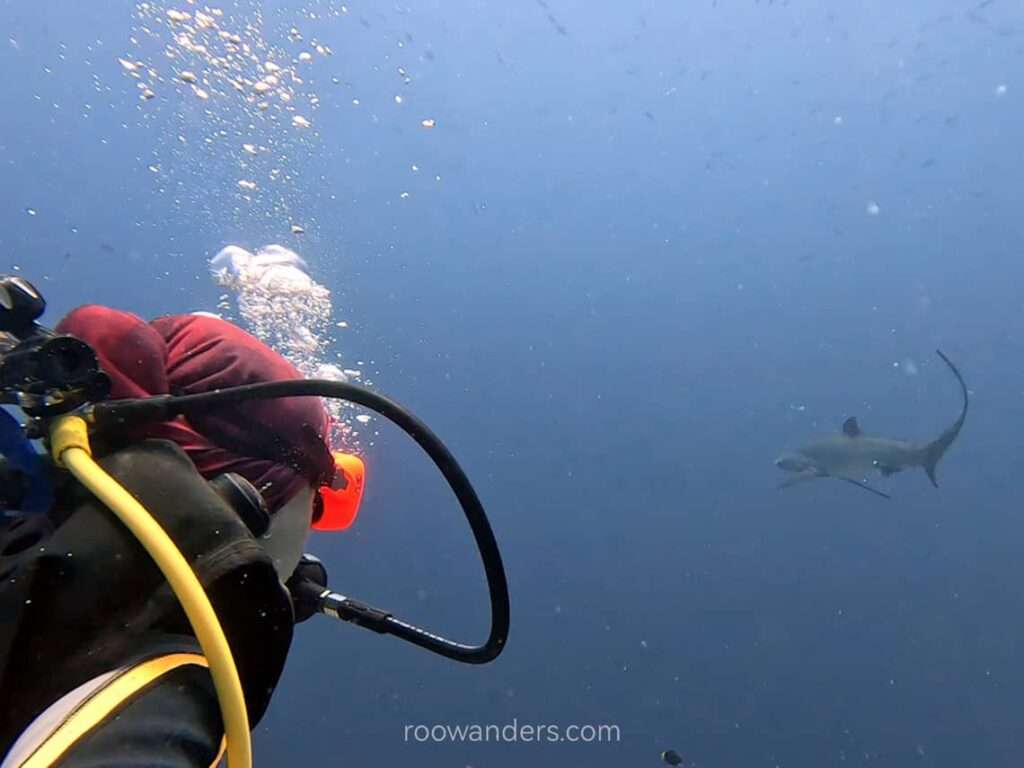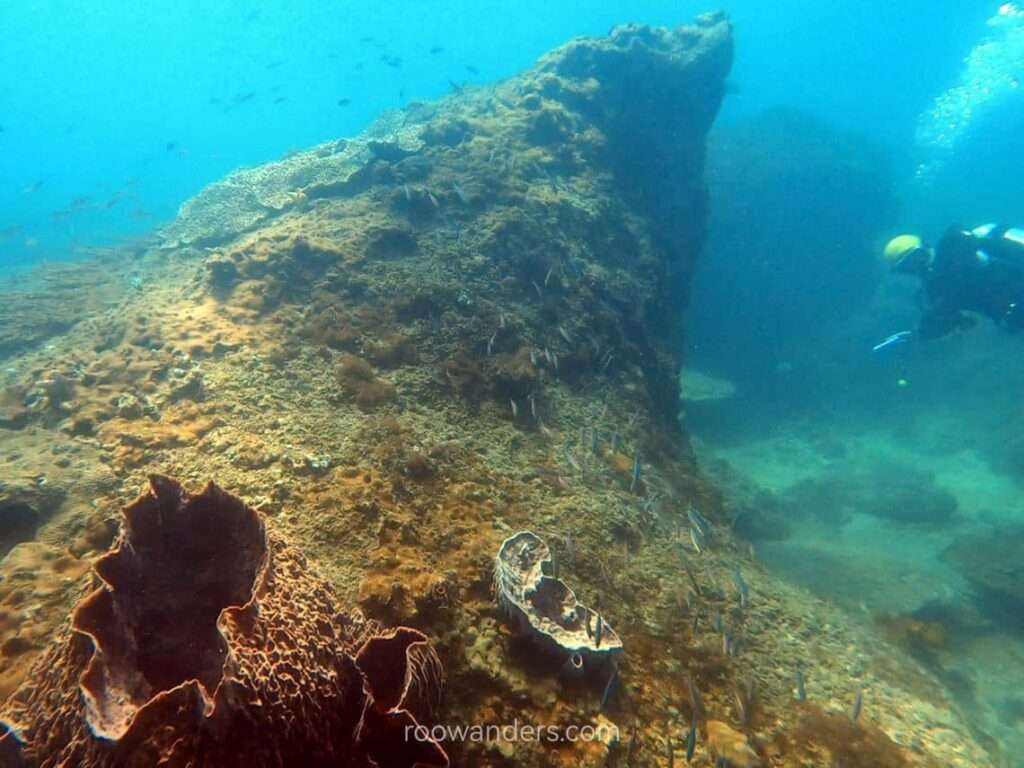
Wreck Dives in Brunei
Brunei has a plethora of wreck dives for some deep blue adventures.
The seas off Brunei’s 160 km coastline have welcomed and witnessed active trade shipping, fearless explorers, and devastating conflicts as far as one can trace back.
With that, we have casualties of the sea brought about by war and poor weather. The sunken vessels have left the marine creatures new sites to call home and us bubble blowers a day or more to paddle through!
My dive trip to Brunei happened due to a long weekend in Singapore and the need to put a tick on the last ASEAN country on my list. The decision to dive came top on our list of activities, and we scheduled our time around it within our 4D3N itinerary.

I visited Brunei in Aug 2024. Apologies for the awful photos herein grabbed from my GoPro, compounded by the lack of good lighting in a poor visibility environment. This post contains affiliate links that cost nothing to you but support my blog! It may also be updated periodically. Cheers!
Best Time to Dive
I would assume diving in Brunei is similar to diving in Miri since they share the same coastline of Borneo.
According to several dive sites, it is possible to dive all year round, but for the best visibility, choose the months of March to September.
Someone commented about diving outside the rainy season for better visibility and avoiding the 3 days leading up to and after a full or new moon, which can result in stronger currents and disturbed sediments.
As Borneo is in the tropical region, the waters are perpetually warm – a 3 mm wetsuit or just plain old rashguard would have sufficed. Since we’re talking about wreck dives, be prepared to protect yourself from scratches and cuts.
The Northeast Monsoon occurs from November to February, bringing lots of rain and wind. Year-end holiday diving is not ideal.

My Dives
1) Australian Wreck
The name given to this 94 m wreck has nothing to do with Australia. Rather, the theories surrounding it – a warship presumably struck by the Australian Airforce/ torpedoes – led to its name.
Built in 1909 in Amsterdam, SS De Klerk is a Dutch-made ship first commissioned as a passenger-cargo liner.
The ship was scuttled by the Dutch Navy in 1942 in an attempt to prevent her use by the invading Japanese troops.
But the Japanese successfully salvaged the sunken ship and renamed her Imaji Maru.
Imaji Maru eventually came to her demise towards the end of the war in 1944, when she ironically struck a Japanese mine in Brunei waters. 339 passengers, mostly prisoners of war, comfort women, labourers and Japanese soldiers sank with the ship.
Their remains, along with the cargo the ship carried, can be found in the intact shipwreck, lying about 35 m below sea level.

During my dive, visibility was poor at 1 – 1.5m, with greenish water.
The Australian Wreck lies tilted, with the shallowest part around 23 m below sea level. We swam through the upper deck underneath the verticals, which was a terrifying experience as the first wreck dive of the day.




Good buoyancy, gloves and a full-length wetsuit or rashguard are a must, or you’d end up with cuts and bruises from the sharp ends of rusted beams or shells. Having a personal torch works wonders in this case, as illustrated by my colourless screengrabs. Time to go shopping.
The last wreck dive I did was at Stellar Maru in Mauritius, where visibility extends beyond 30 m. We couldn’t dive within the wreckage, so this series of wreck dives in Brunei were firsts for me.
I did not see any corals but spotted the shadows of a group of longish yellowtail barracuda, three lionfish huddling by a protrusion, and a few unknown schools of fish. The highlights of this dive include paddling through the hull and the toilet bowls rising from the silts.
We spent about 45 mins diving here, achieving a maximum depth of 30 m at some point.
Compared to the photos Ram Yoro shared, the silt has accumulated considerably. Chances of seeing skeletal remains are low unless you floundered and disturbed the settled sediment!
Some divers remarked the site was haunted. I would think so as I was paddling in murky green water through the hull.

2) American Wreck
The American Wreck, known as USS Salute AM-294, is a minesweeper commissioned in 1942/3 at Seattle during WWII.
Salute was frequently sent to the Pacific Sea to provide pre-invasion clearing support. She was eventually dispatched to conduct sweeps in the Philippines, including supporting the Leyte invasion and clearing grounds for landings at various parts of the Philippines.
However, she met her demise in June 1945 while sweeping the coast of Brunei in preparation for the Battle of Borneo. A mine tore through her underbelly, breaking her into two as she sank to a depth of 30 m. 9 American soldiers perished with her.

Compared to my first dive, expectations have now been established for wreck dives. I had also gotten used to my loan gear. Visibility was comparatively slightly better at 2 – 2.5 m.
We stuck to the sides of the wreck, checking out the strewn rusty bullets, and paddling over several giant broken metal slabs where the mine had likely blown through. We saw the same types of fish as the first dive – barracuda, lionfish and a group of Yellowfin Snappers.
Our dive around the American Wreck was short ~30 mins, and we reached a depth of 30 m. According to the guides, this wreck is not safe to dive within.





3) Dolphin 88 Wreck
Our last dive of the day at Dolphin88 was a blast with the best visibility of 5 m out of the three sites visited!
Not crystal clear like diving in Malapascua for thresher sharks (visibility went beyond 30 m!) but I’m glad to finally see more marine creatures, corals and the size of the wreckage than blurry green murkiness.
Dolphin88 is not a war casualty. The Malaysian barge was carrying a shipment of stone through Brunei water when it encountered bad weather and sank in 2013. All 11 crews were rescued, and the wreck is now a popular dive site replete with corals and fish. The ship split into two, with the back half settling to a depth of 24 m, while the shallower top lies around 10 m.
We saw several graceful longfin bannerfish, a few curious longfin batfish, a baby pufferfish, one yellow boxfish, a handful of ornate angelfish, an angry-looking stonefish and a huge school of fluttering yellowfin snapper.
As with the Australian Wreck, we could penetrate and explore the wreck. We spent about 50 mins paddling around this dive site, hitting the max depth of 22 m at some point, before surfacing.







Other Wrecks/ Sites in Brunei
If you’re a wreck diver junkie, there are a handful more wrecks, including an oil rig, to check out as a recreational diver. Another handful exists in depths beyond 30 m for qualified technical divers.
Located just outside the rims of the biodiverse Coral Triangle, Brunei has its fair share of beautiful reefs and their inhabitants, suitable for those learning to dive.

Accommodations in Brunei
We stayed at Poni Homestay in Muara but dived with Oceanic Quest, which is 20 minute walk away. Budget-conscious us did a cost comparison and found diving with OQ B$30 cheaper than Poni Divers. Would the extra B$30 mean better quality dives for Poni, e.g. better-rented gear and more attentive dive guides? 🤷
Nevertheless, our stay with Poni Homestay was highly recommended for the hospitality, convenience, free airport shuttles, and complimentary breakfast of roti, fried rice, or fried noodles. They have cute cats and are around the corner from a supermarket and a few delicious eateries!
There are no known hotels or other accommodations in Muara. Your next best accommodations would be in Bandar Seri Begawan and Gadong. It takes about 30 mins to travel from both to Poni or OQ. Both dive centres can arrange for a return transport at a cost.
Affordable accommodation in Gadong includes EZ Suites and Miniinn Guest House. The Centrepoint, opposite The Mall in Gadong, is the more premium of the three. All lodgings are within walking distance of the bustling Gadong Night Market.
Other notable hotels include the centrally located Radisson Hotel, The Brunei Hotel, and The Capital Residence.

Kunyit 7 Lodge in the Water Village is a unique stay and experience the life of the locals. You might have to arrange a B$1 boat ride back to the mainland for pickups.

The fanciest hotel that is splurge-worthy ought to be The Empire Hotel. According to past patrons, the hotel looks and feels like a palace with top-notch hospitality, making one feel well-treated like royalty. They have a beach with stellar sea views and sunsets.

Conclusion/ Rambles
Wreck diving in murky conditions was a novel and terrifying experience at the beginning for someone holding an Advanced Cert with slightly less than 40 dives under her belt.
My last dives were in the painfully clear water of Malapascua and Moalboal. We were kneeling on the bed at depths of 30 m and could still see the outline of our boat bobbing at the top!

I have dived along the same coastline while travelling in Miri, but was restricted to two reef dives due to days of bad weather. The coast off Miri has a protected reef national park and two wrecks.

My only wreck dive before all these dives was around the periphery of Stella Maru in Mauritius. I dived into an equally clear and undisturbed water stretching beyond 30 m.

Penetrating the ghastly Australian Wreck as the first dive of the day with rented gear and poor visibility made me fidget with worry at the start. But I soon grew accustomed to the gear and increased awareness of the verticals and obstacles surrounding me in the wreck for the following dives, never mind the few cuts and bruises sustained for wearing a shortie.
These dives also made me realise the importance of a rashguard and a powerful torch. Time to get some minor upgrades!







